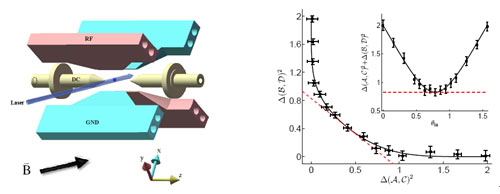In collaboration with Professor Zhihao Ma in Shanghai JiaoTong University and Professor Vlatko Vedral in University of Oxford in U.K., Professor Mang Feng’s group for Bound-System Quantum Information Processing at Wuhan Institute of Physics and Mathematics (WIPM), Chinese Academy of Sciences has just published their latest research about verifying Heisenberg’s uncertainty relation in Science Advances(2016;2: e1600578).
Heisenberg's uncertainty relation has been profoundly influencing the development of quantum physics. It gives the reachable limit of measurement precision in the quantum world, but the specific form and value of the limit have been debated for years. Recently, Busch, Lahti, and Werner (BLW) proposed and proved an error-disturbance inequality which follows the spirit of Heisenberg’s original idea in 1927. Their work attributes the amount of uncertainty of a joint measurement of two non–commuting operators to the statistical distance between the probability distributions of the measurements. As such, the uncertainty of this joint measurement can characterize the inaccuracy of the measurement instrument, which is independent of specific quantum states.
Ultracold ions (T=0.5μK) isolated in an electromagnetic potential under precise manipulation has been an important experimental platform for exploring quantum information science and fundamentals in quantum physics. By precisely manipulating the spin evolution of a single ultracold 40Ca+ ion, Fei Zhou, Leilei Yan, Shijie Gong et al observed the lower bound of the uncertainty relation in good agreement with the theoretical prediction, after getting rid of the experimentally determined imperfections. Since the experimental operations were very accurate (with fidelity of 99.8%), the experimental observation credibly verified the error-disturbance inequality of BLW theory. This is the first experiment in a fundamental quantum system observing the lower bound of the uncertainty, which would be very useful for quantum precision measurement and quantum cryptography, since the lower bound of uncertainty is relevant to the error calibration in precision measurement and to the security in quantum key distribution. The result might also be practical for large-scale precision measurement, such as gravitational-wave measurement.
This work has been highly praised by the three reviewers. One of the reviewers commented as ‘Heisenberg (and other physicists interested in the foundations of quantum physics) would presumably have been delighted seeing such experiments where individual quantum system can be deterministically prepared and read-out with near unity detection efficiency.’
The research is supported by National Fundamental Science Research Program 'Engineering quantum states in coupled systems of trapped single-atoms (ions) and light' and by National Natural Science Foundation of China.

(Left) Ion trap device; (Right) Experimental verification of the error-disturbance inequality, where the black dots with error bars represent experimental data, black lines denote theoretical predictions and the red dashed lines are for the lower bounds of the uncertainty.